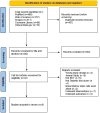Therapeutic potential of adipose-derived stem cells for diabetic foot ulcers: a systematic review and meta-analysis
- PMID: 39773633
- PMCID: PMC11706097
- DOI: 10.1186/s13098-024-01523-5
Therapeutic potential of adipose-derived stem cells for diabetic foot ulcers: a systematic review and meta-analysis
Abstract
Background: As the global prevalence of diabetes mellitus increases, the incidence of non-healing wounds in diabetic patients is expected to rise significantly, according to the International Diabetes Federation (IDF), around 537 million adults currently suffer from diabetes mellitus worldwide and 20% to 30% of individuals with diabetes are hospitalized due to diabetic foot ulcers. Conventional treatments such as traditional dressings often fall short in ensuring satisfactory wound healing, this Meta-analysis investigates the therapeutic potential of Adipose-derived Stem Cells (ADSCs) as a promising strategy for addressing this challenge.
Aims: To Assess the Therapeutic Potential of Adipose-Derived Stem Cells for Managing Diabetic Foot Ulcers compared to conventional lines of treatments.
Methods: The PubMed, SCOPUS, Web of Science Core Collection, Cochrane Library, and ClinicalTrials.gov. databases were searched from January 2000 and December 2023, articles were primarily evaluated regarding their titles and abstracts, then full-text screening was assessed against the inclusion and exclusion criteria by utilizing Rayyan software. The Cochrane risk of bias (RoB 2) assessment tool was used to identify the risk of bias in our included studies. A statistical analysis was performed using Review Manager (RevMan) Version 5 software. Dichotomous data was subjected to risk ratio analysis, while continuous data underwent Mean Difference (MD) evaluation, all was reported with 95% confidence intervals, P value is considered statistically significant if less than 0.05.
Results: Regarding the total healing state, five studies reported that more participants healed completely at the end of the follow-up period in the ADSCs group (Risk ratio = 1.56, 95% CI [1.32, 1.86], P < 0.00001), for the healing rate the overall effect estimate favors the ADSCs group (pooled effect estimate = 1.84, 95% CI [1.51, 2.89], P < 0.00001), and regarding the healing time the pooled mean difference of the studies demonstrated that the ADSCs group required fewer days to heal than the standard care group. (pooled mean difference = -19.33, 95% CI [-37.36, -1.29], P = 0.04).
Conclusion: ADSCs provide favorable healing results and safety compared to standard care for diabetic foot ulcers.
Keywords: Adipose stem cells; Diabetes; Diabetic foot ulcers; Regenerative medicine; Stem cells.
© 2024. The Author(s).
Conflict of interest statement
Declarations. Ethics approval and consent to participate: Not applicable. Consent for publication: Not applicable. Competing interests: The authors declare no competing interests.
Figures







References
-
- Frykberg RG, Franks PJ, Edmonds M, Brantley JN, Téot L, Wild T, et al. A multinational, multicenter, randomized, double-blinded, placebo-controlled trial to evaluate the efficacy of cyclical topical wound oxygen (TWO2) therapy in the treatment of chronic diabetic foot ulcers: The TwO2 study. Diabetes Care. 2020;43:616–24. - PubMed
-
- IDF Diabetes Atlas. 10th edn. Brussels, Belgium: International Diabetes Federation; 2021.
-
- Armstrong DG, Boulton AJM, Bus SA. Diabetic foot ulcers and their recurrence. N Engl J Med. 2017;376:2367–75. - PubMed
Publication types
LinkOut - more resources
Full Text Sources
Research Materials

